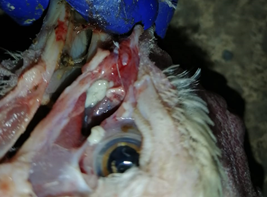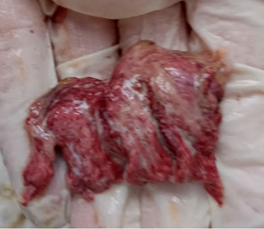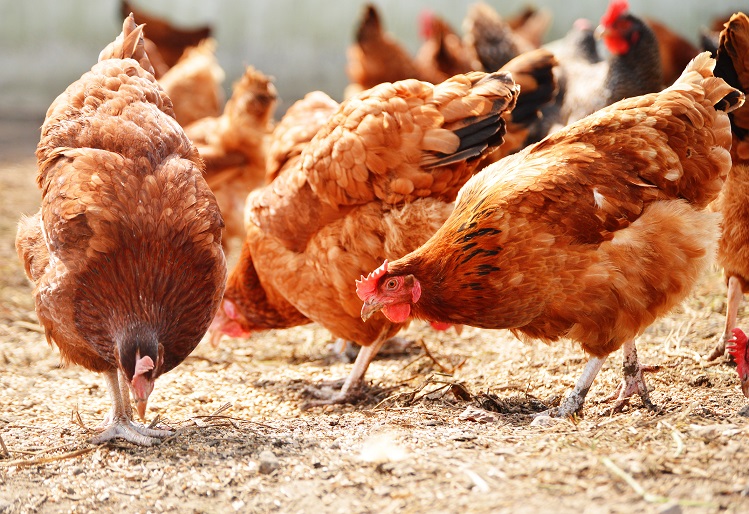Essential oils for poultry health
Malakheeva L.I., Ph. Javier Prieto Jiménez Poultry veterinarian and nutritionist
The growth, development and normal functioning of tissues in a living organism is impossible without an optimal supply of sufficient oxygen to ensure oxidation of nutrients and energy synthesis. Therefore, the health of the pulmonary system largely determines the general well-being of poultry and is the key to high production performance.
The growth, development and normal functioning of tissues in a living organism is impossible without an optimal supply of sufficient oxygen to ensure oxidation of nutrients and energy synthesis. Therefore, the health of the pulmonary system largely determines the general well-being of poultry and is the key to high production performance. In the conditions of intensive system of modern production, aimed at obtaining the maximum amount of product per unit of useful area, most often by increasing the planting density, the development of a preventive system to maintain optimal parameters of the functional state of the lungs is becoming increasingly important.
Etiology and development of respiratory symptom complex (syndrome) in birds.
The International Classification of Diseases does not describe respiratory symptom complex (syndrome) - RS- as a separate nosological unit, but this term, actively used by practitioners, implies a set of symptoms characterizing the violation of integrity and functional activity of tissues of the respiratory tract. In conditions of modern production, this pathology almost never develops as a result of a single cause, but is a consequence of a group of etiological factors, including violation of housing technology (associated primarily with deterioration of microclimate parameters: high content of ammonia, dust and carbon dioxide; high or low humidity/temperature), the presence of infectious agents that have a tropism to the tissues of the respiratory tract, poor quality feed, which does not provide the bird with the necessary nutrients and nutrients.
Inflammatory reactions, often resulting from the use of highly immunogenic and, as a rule, more reactive vaccines against the main respiratory diseases of birds, should be singled out. Primary infections such as respiratory mycoplasmosis, infectious bronchitis of chickens, haemophillosis, etc., as well as violation of vaccination technology without taking into account the actual conditions of microclimate in the housing can also be attributed to provoking this process.

Despite the fact that some infectious agents can cause diseases without associated factors, still, most of them in practice are secondary, complicating the main inflammatory process circumstances. High concentrations of Enterobacteriaceae and cocci in the air of poultry houses provoke an active immune response, resulting in a more severe course of the disease. As a result of anatomical features of the circulatory system of the mucous membrane of the upper respiratory tract and sinuses, the development of respiratory syndrome begins with blood stasis in and exit of part of the plasma into the intercellular space, which leads to the development of hypoxia and the formation of mucous exudate. With the development of secondary microflora and cellular reaction on the part of immune system the character of exudate changes, which changes into serous and purulent forms (see picture 1.). Its entry into the lower parts of the respiratory tract causes generalization of the inflammatory process with the formation of tracheitis, pneumonia and aerosaculitis, narrowing of the lumen of the trachea and bronchi, resulting in decreased oxygen supply to the bloodstream (see picture 2), leading to a state of general hypoxia, oppression and reduced feed consumption. Like any inflammatory reaction, MS is accompanied by receptor irritation and the development of pain symptom provoking bronchospasm, further impairing oxygen supply. As a consequence of general intoxication, the bird becomes depressed, refuses feed (most often water), decreases motor activity, and begins to slow down the dynamics of live weight gain, up to its loss.

When exudate accumulates in the respiratory tract, a complex of reflex reactions develops, aimed at clearing the respiratory tract and restoring its permeability to air masses: sneezing; attempts to mechanically free visible mucous membranes from inflammatory exudate: the bird rubs the eyes, nasal orifices; stretches the neck to facilitate breathing, wheezing, etc.).
Thus, ethiotropic therapy aimed at elimination of only one factor - the primary pathologic agent - is not always effective enough and leads to recovery of the bird. Moreover, mass accumulation of cellular detritus can provoke complication of the course of inflammatory process and increase of waste, even in the further absence of the pathogen. In this case, according to the practice generally accepted in the world medicine, drug therapy should be supplemented by pathogenetic, aimed at reducing intoxication and controlling the pathological process, and symptomatic, oriented at reducing individual symptoms, methods. Taking into account the labor-intensive and cost-effective use of a large number of drugs, the goal of modern veterinary medicine in industrial poultry farming is to select means having a wide range of therapeutic activity, in particular, possessing antiseptic, mucolytic, expectorant, antispasmodic and other actions aimed at restoration of functional activity of respiratory organs.
Use of essential oils in the prevention and treatment of MS in birds.
The most well studied and proven for centuries in the treatment of respiratory diseases is phytotherapy, based on the use of whole or processed plant material [1]. Recently, this method is again gaining widespread use, due to its scientific rationale, formed as a result of a large number of studies using modern diagnostic methods that have proven its effectiveness, even in cases of severe viral infections. Currently, none of the treatment regimens for acute respiratory diseases (ARI) can do without the use of these products. Special interest in these products in agriculture is associated with the task of reducing the use of chemotherapeutic agents in veterinary medicine [2].
However, of great importance is the processing and method of use of plant raw materials, which include a significant number of different components, some of which do not have therapeutic properties, and in some cases has a toxic or anti-nutritional effect. The concentration of biologically active substances (DBAV) is extremely low, which does not allow to achieve significant treatment results when using extracts or dried plant material. Thus, the content of eucalyptol (1.8 cineole), which is a monocyclic terpene and is the main DBAV of plants of the genus Eucalyptus, with pronounced antiseptic, anti-inflammatory, anesthetic activity, varies in plant raw materials from 1.2 to 3.5% by weight [3]. Of greatest interest in the light of the above are preparations that are a complex of biologically active substances isolated from plant raw materials, purified from ballast components and amenable to laboratory control and standardization.
Since the absolute majority of respiratory infections in poultry farming have viral etiology, and the most frequent complicating the course of the disease is the development of secondary bacterial and fungal microflora, components of antiseptic nature, i.e. possessing antibacterial, antiviral, antifungal properties are of high value. As mentioned above, one such active ingredient is eucalyptol, as well as thymol and carvacrol (monoterpene phenols that are part of thyme) and anethol, an organic compound synthesized from anise and star anise. At the same time, these products can enhance the antimicrobial activity of other antiseptic agents, in particular chlorhexidine [4]. In addition to these DBAVs, the composition of the preparation MIAROM liquid® includes other active components of essential oils of eucalyptus, thyme, anise and mint: flavonoids, triterpene compounds, tannins, etc., due to which a wide range of active action is achieved. In particular, the positive effect of essential oils of eucalyptus and peppermint to reduce the severity of inflammatory response, in particular, edema by reducing the permeability of blood vessels and effusion of liquid part in the intercellular space, desquamation of epithelium during infection of vaccinated and unvaccinated birds against ND (Newcastle disease) with a highly virulent strain of ND virus was described in an article by Pakistani scientists, where an increase in the titer of post vaccinal antibodies in ELISA and RSHA in the presence of a mixture of essential oils was also noted [5]. The latter fact was confirmed in the works of other researchers, who also noted an increase in antioxidant protection of adult birds and daily youngsters in the case of using MIAROM liquid® for parental flocks of cross Ross-308 by drinking at a dose of 100 ml per ton of water for a course of 7 days [6,7]. Additional antioxidant effect of essential oils of anise, peppermint, eucalyptus prevents lipid hyper peroxidation resulting from the development of local immune response and, as a consequence, damage to cell membranes [8].
In addition to reducing congestion in MS, an important point in pathogenetic therapy is the liquefaction and excretion of exudate formed as a protective reaction of the body in response to the effects of a pathological agent and then contribute to the spread of the inflammatory process to the underlying parts of the respiratory system. Increased synthesis of the liquid part of the tracheobronchial secretion occurs as a result of the action of bitters, which are part of essential oils. Also due to reflex irritation there is restoration and strengthening of the drainage function of the mesenteric epithelium, which is an important mechanism of sanitation of the respiratory tract [9, 10]. The presence of bitters also stimulates the secretion of digestive juices, which contributes to increased appetite and improved weight gain.
As mentioned above, the main reason for the development of bronchospasm is the pain symptom as an integral part of any inflammatory process. In this case, the anesthetic effect of menthol and eucalyptol, especially at their direct exposure in the focus of inflammation, which is achieved by aerosol method using the drug, the so-called "cold fog", leads to elimination of spasm, improvement of exudate removal, increasing the patency of the airway for air masses.
Ways of using essential oils in poultry production
The methods of application of essential oil products in poultry farming are diverse and include use with drinking water, feed, aerosol methods: coarse spray, "cold mist" and vaporization (e.g. through evaporation panels), as well as combinations of the above forms. Clinical efficacy of preparations directly depends on the correct choice of both the product itself and the method of its application. Thus, in case of obvious reduction of feed consumption by birds during the initial period of the disease there is no expediency of introducing drugs into mixed fodder. In this case, the maximum effect is achieved by using aerosol treatments, which allow to achieve high concentration of DBAV directly in the inflammation focus. However, if dosage of preparations based on essential oils through feed and water, as a rule, is not difficult, then calculation of concentration of the working solution and its consumption per cubic meter of the treated room at aerosol treatments is complicated by the necessity to establish initial parameters of microclimate, current condition of poultry, technical characteristics of the product itself, because preparations with a high content of essential oils require significant input of emulsifiers to prevent adhesion of aerosol particles on equipment and working surfaces. The use of a combination of several non-ionic surfactants in MIAROM liquid®, characterized by a high concentration of essential oils, expands the range of its application and increases the breadth of therapeutic and preventive action, not limited to the respiratory system.

List of references used:
1. Stremoukhov A.A., Zaplatnikov A.L., Vlasova N.L., Smirnova M.A. Phytotherapy of infectious and inflammatory diseases of the upper respiratory tract in outpatient therapeutic and general medical practice. RMZ. Medical Review. 2022; 6(8):419-426. DOI: 10.32364/2587- 6821-2022-6-8-419-426. 2. Summary of the work program for the European Medicines Agency. London, 2006. P.1- 30. EMEA/62913/2006. 3. Sebei K., Sakouhi F., Herchi W. et al. Chemical composition and antibacterial activities of seven Eucalyptus species essential oils leaves. Biological res. 2015. 48, 7. https://doi.org/10.1186/0717-6287-48-7 4. Şimşek M, Duman R. Investigation of Effect of 1,8-cineole on Antimicrobial Activity of Chlorhexidine Gluconate. Pharmacognosy Res. 2017 Jul-Sep;9(3):234-237. doi: 10.4103/0974- 8490.210329. PMID: 28827963; PMCID: PMC5541478. 5. Awaad M.H.H., Afify M.A.A., Zoulfekar S.A., Mohammed F.F., Elmenawy M.A. and Hafez H.M. Modulating effect of peppermint and eucalyptus essential oils on vVND infected chickens. Pak Vet J, 2016. 36(3): 350-355. 6. Majeed Z., Mustafa N. Impact Laying Times of Broiler Breeder Supplement with Aromatic Oils (Miarom) in drinking water on Hatchability, Maternal immunity and serum antioxidant and antioxidant Statues hatched chicks. Tikrit Journal for Agricultural Sciences. 2023; (1): 44-50. https://doi.org/10.25130/tjas.23.1.6. 7. Farhadi D., Karimi A., Sadeghi G., Sheikhahmadi A., Habibian M., Raei A., Sobhani K. Effects of using eucalyptus (Eucalyptusglobulus L.) leaf powder and its essential oil on growth performance and immune response of broiler chickens. Iran J Vet Res. 2017 Winter;18(1):60-62. PMID: 28588635; PMCID: PMC5454581. 8. Cai Z.M., Peng J.Q., Chen Y., Tao L., Zhang Y.Y., Fu L.Y., Long Q.D., Shen X.C.. 1,8-Cineole: a review of sources, biological activities, and applications. J Asian Nat Prod Res. 2021 Oct;23(10):938-954. doi: 10.1080/10286020.2020.1839432. Epub 2020 Oct 28. PMID: 33111547. 9. Jeane S., Worku A., Sousa S.M., Duarte V.G., Machado M.I.L., Matos F.J.A. Analgesic and anti-inflammatory effects of essential oils of Eucalyptus, Journal of Ethnopharmacology, Volume 89, Issues 2-3, 2003, Pages 277-283, ISSN 0378-8741, https://doi.org/10.1016/j.jep.2003.09.007. 10. Kalinkina G.I., Kolomiets N.E. Fundamentals of phytotherapy: textbook. - Tomsk: Siberian State Medical University, 2014. - 84 с.